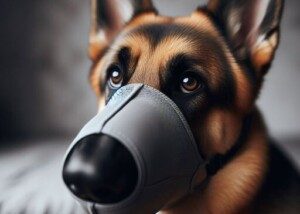
Giving injections to big dogs can be a major hassle, so here are guidelines for giving injections to large dogs without assistance.
I had been giving injections to a large dog for several weeks, and that’s been plenty of time for me to figure out some tricks to make this task as easy as possible.
I’ve been giving a large dog 12 injections per day — yes, 12, and these are done in the morning and evening, divided into six injections, one injection every 10 minutes.
My guidelines for giving shots to a big dog may not apply to your particular situation, since variables will be at play, such as size of the syringe, and perhaps restrictions by your vet regarding where to place the needle.
In my case, the only restriction is don’t make injection on dog’s midline, but anywhere else goes, preferably rib/abdominal area below midline (use common sense — you’d never inject a dog on the snout or in the ear unless directed by your vet).
The treatment protocol may also vary in that some injections for dogs must be administered subcutaneously, while others intramuscularly.
In the case of my parents’ dog, these are subcutaneous (under the skin) injections.
GUIDELINES
#1: Put a muzzle on your pet. Leave the muzzle on for about 30 minutes before the shot so that the dog does not associate the muzzle with getting “stabbed.”
#2: If possible, give injections when the dog is tired, perhaps later in the evening when your pet begins winding down and getting sleepy.
#3: Give the injections quickly. A slow, prolonged shot is more painful. Get in and out with the needle quickly, but make sure you don’t miss the target, either.
#4: It’s best to give the shots while the dog is lying, at least in my case. If given while he’s on all fours, he can jerk or scamper away from the needle before all the medication gets inside him.
In fact, this can also happen if he’s lying down, depending on where you place the needle.
Thus, part B of point 4 here is find the location on your pet in which, if he jerks, will minimize displacement of the needle.
On my parents’ dog, if he’s lying towards one side, rather than square and even on his belly, placing needle to the portion of his belly that’s not leaning into the floor is the best bet, because if he tries to jerk away from the needle, the jerking will occur towards the floor that he’s lying on, and hence, he won’t be able to get away from the needle.
#5:Commit yourself to following through on the injection!
A knee-jerk reaction is to pull the needle away, or withdraw the needle, the instant the dog reacts.
My mother tried twice to inject him, and was not able to follow through with the injection because of the knee-jerk reaction on her part when the dog snarled and reacted. Commit to pushing all the way through on the syringe no matter what.
This will be difficult for some people. My brother has told me more than once, “I could never do what you’re doing,” and this is a man who prides himself in being tough and macho, a weightlifter who has gone skydiving, scuba diving, rock climbing, backwoods hiking, and shoots guns.
#5b: Accept that the dog will always loudly snarl or bark. Do not let this make you give an incomplete injection.
#5c: Come to think of the snarling or barking as “cute.” Yes, I’m serious. Our dog’s snarling/barking is deep and guttural, a true show of his machismo!
#5d: Accept that the dog will try to nip your hand. Our dog has tried to do this to me a number of times, and the muzzle prevents him from taking an actual bite.
But the muzzle comes in contact with my hand nevertheless. I think this is cute; he’s trying to nip me but the muzzle is in the way and he can’t figure out why the nip didn’t happen!
Call me deranged for thinking this way, but you must do what you must do to follow through with the injection!
Once the muzzle taps your hand, you will realize how safe it is to inject your large dog; a muzzle will outright prevent getting bit, but make sure it’s the right kind of muzzle!
The muzzles made of denim will not prevent getting bitten. The one I use is made of some kind of rubbery-plastic material and is not solid, but rather, composed of criss-crossing bars; this allows a dog to drink through the contraption, but he cannot bite at anything.
Some people will still find it difficult to get past the fact that their dog snarls and tries to nip them.
Again, commit to following through with the injection, realizing that a properly muzzled dog will not be able to bite you, and that it’s harmless for the muzzle to tap your hand as the dog tries to nip you.
If you’re still struggling, close your eyes while injecting the big dog (get needle positioned first); if you can see the dog reacting, this might cause you to prematurely withdraw the needle.
#6: Lovingly stroke the dog before, and after, every injection, so that he doesn’t think you’re cruel.
We’re convinced that our large dog, a German shepherd, somehow knows that I’m helping him with the injections, that it’s something he must get for his own good, because usually, when he sees me approaching with the syringe while he’s lying on the floor, he stays there!
He knows what’s coming, but he remains in place, and we’re talking one shot every 10 minutes for six total, twice a day.
Finally, and so important–can’t say it enough–when giving your large dog injections, make sure that none of the substance “misses” the entry point.









































